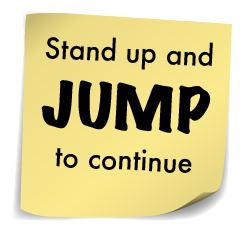
by Annie | Dec 14, 2011 | Game Design
MotionMaze Holiday Adventure is now out on the App Store! This new version of MotionMaze features over 100 brand new mazes filled with pickups, as well as a Daily Scramble that offers a new maze every single day. So what are you waiting for? Try out MotionMaze Holiday Adventure...

by Annie | Nov 23, 2011 | Game Design, Psychology of Games
A new version of Pop & Dodge is now available on the App Store. This version includes new powerups, new achievements, and a new tap mode. …wait a second. Tap mode? Aren’t our games supposed to be about physical activity? Exactly. In fact, that’s precisely why we put in Rookie Mode, where you can play the same game by tapping instead of jumping. The hook? The Advanced Mode (jump to play) offers more powerups, more points, and more achievements. Rookie Mode allows you to play Pop & Dodge when you’re on the bus, in the car, or anywhere else where you just can’t jump. Through tapping, you familiarize yourself with the mechanics of the game by using more standard iPhone inputs (i.e., tapping instead of jumping). We know this could be a risky move. Sure, there might be people who only play Rookie Mode and never convert to jumping. But that’s okay. We can’t force people to jump; we can only encourage them to do so through solid game mechanics and motivating rewards. Offering a tap mode allows us to reach players within their comfort zone and gently push them to change their habits, instead of starting out with something completely foreign. So now you’ve got no excuse. Whether you’re sitting, standing, or lying down, you can play Pop & Dodge anywhere, anytime. So grab the latest update...

by Annie | Nov 10, 2011 | Game Design, Psychology of Games
Growing up, I was tasked with practicing the piano a solid hour a day. Didn’t matter what I did within that hour, as long as I sat on that bench for 60 minutes. My parents figured that more practice time would naturally yield greater increases in musical skill. And this is true, to an extent. Experts now recommend that practice sessions, especially for young kids, are broken up into several short sessions a day. Three 10-minute sessions are better than one 30-minute session. Why? Because kids have short attention spans and need breaks. Shorter sessions come with greater focus and more purposeful practice. This is the same realization we’ve come to in our games. Sure, we can get people to try it out, but what’s more valuable is getting those people to come back day after day, several times a day. Retention is key. This is especially important for the types of games we’re making. In order to make any change in people’s physical activity habits, we have to keep them coming back. One play session that gets you out of breath is great, but it’s not a lifestyle change. To get people off the couch time and again, we have to facilitate habit-forming gameplay. How? We dig into our game design toolbox. Help players realize the importance of exercise, create compelling mechanics to get them moving, provide feedback to reinforce specific behaviors, and dole out rewards that matter. Easier said than done, but don’t you worry. We’ve got some ideas that will blow your socks off. Or at the very least, get you off that...

by Annie | Oct 28, 2011 | Game Design
The purpose of developing MotionMaze and Pop & Dodge within such rapid production cycles (2-3 weeks each) was to learn as much as possible as quickly as possible. And boy, have we learned some valuable lessons. Lesson 1: This is new. One of the most eye-opening experiences came at a playtest session we did with elementary school kids. We handed them the iPod, and most kids immediately sat down, tapping through the screens, then trying swipe and tilt. We realized that our main mechanics consist of unexpected controls, so we must spell e-v-e-r-y-t-h-i-n-g out so the player understands this new experience. Lesson 2: Give people a reason to jump. People like to play games sitting down. It’s become the norm, and frankly, after a long day, who wants to have to do physical activity to play a game? The game has to be playable on a basic level without physical controls but provide an added layer of powerful incentives to lure the player to get out of their comfort zone and move around. If you tell a player to jump, they might do it once or twice, quickly getting bored or tired. If you provide motivation to jump, players will stay on their feet and soon forget they’re actually jumping. Lesson 3: Make sure it works. Duh, right? Well, with physical activity, movement detection isn’t always reliable. Everyone moves differently and interacts with iDevices in different ways. After going through rounds of testing full of over- and under-registered movement, we’ve realized the immense value of creating reliable movement detection. Players expect it, so we should be able to deliver....





